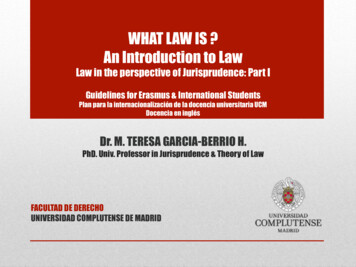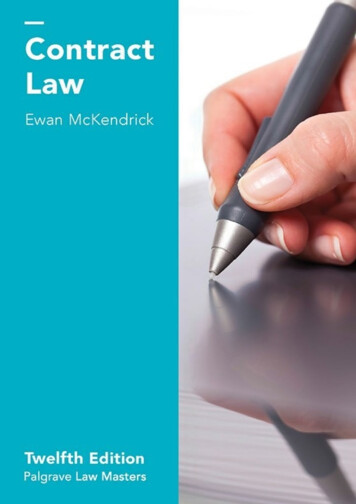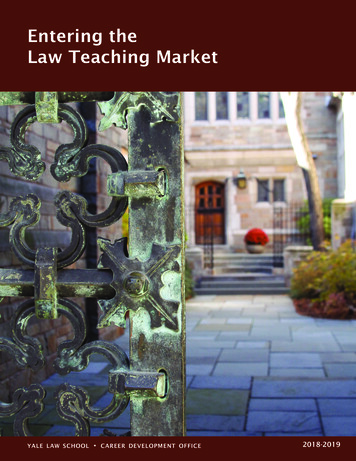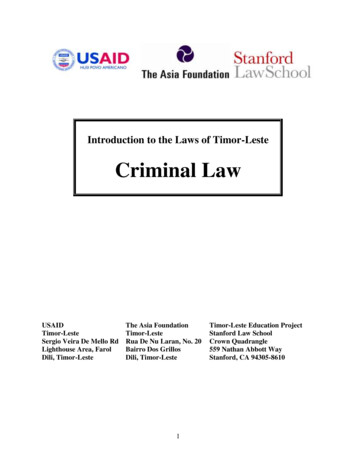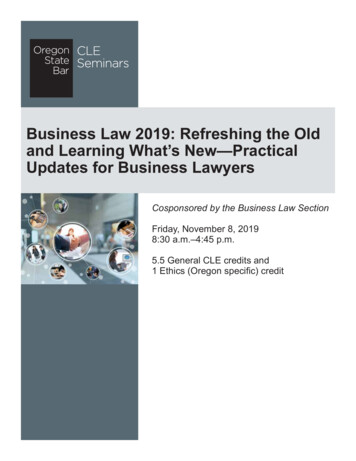
Transcription
Business Law 2019: Refreshing the Oldand Learning What’s New—PracticalUpdates for Business LawyersCosponsored by the Business Law SectionFriday, November 8, 20198:30 a.m.–4:45 p.m.5.5 General CLE credits and1 Ethics (Oregon specific) credit
BUSINESS LAW 2019: REFRESHING THE OLD AND LEARNING WHAT’SNEW—PRACTICAL UPDATES FOR BUSINESS LAWYERSSECTION PLANNERSAdam Adkin, Tonkon Torp LLP, PortlandAnne Arathoon, General Counsel, G5, BendJames Hein, Tonkon Torp LLP, PortlandBenjamin Kearney, Arnold Gallagher PC, EugeneDouglas Lindgren, Standard Insurance Company, PortlandCharmin Shiely, Schwabe Williamson & Wyatt PC, PortlandKara Ellis Tatman, Perkins Coie LLP, PortlandTyler Volm, Black Helterline LLP, PortlandOREGON STATE BAR BUSINESS LAW SECTION EXECUTIVE COMMITTEEValerie Sasaki, ChairGenevieve AuYeung Kiley, Chair-ElectDavid R. Ludwig, Past ChairJeffrey S. Tarr, TreasurerKara Ellis Tatman, SecretaryAnne E. ArathoonWilliam J. GoodlingJames K. HeinBenjamin M. KearneyDouglas LindgrenEmily M. MaassJennifer NichollsDavid G. PostCharmin B. ShielyTyler John VolmCarole Barkley, Advisory MemberThe materials and forms in this manual are published by the Oregon State Bar exclusively for the use of attorneys. Neitherthe Oregon State Bar nor the contributors make either express or implied warranties in regard to the use of the materialsand/or forms. Each attorney must depend on his or her own knowledge of the law and expertise in the use or modificationof these materials.Copyright 2019OREGON STATE BAR16037 SW Upper Boones Ferry RoadP.O. Box 231935Tigard, OR 97281-1935Business Law 2019: Refreshing the Old and Learning What’s New—Practical Updates for Business Lawyersii
TABLE OF CONTENTSSchedule . . . . . . . . . . . . . . . . . . . . . . . . . . . . . . . . . . . . . . . . . . . . . . . . vFaculty . . . . . . . . . . . . . . . . . . . . . . . . . . . . . . . . . . . . . . . . . . . . . . . . vii1.Seven Ways to Identify and Protect a Company’s Intellectual Property . . . . . . . . . 1–i— Christopher Erickson, Tonkon Torp LLP, Portland, Oregon2.Presentation Slides: Building a Culture of Compliance—A View from the Inside . . . .2–i— Moderator: Kara Tatman, Perkins Coie LLP, Portland, Oregon— Lindsey Kantawee, VP and General Counsel, A-dec, Inc., Newberg, Oregon— Meredith Weisshaar, VP, General Counsel, and Corporate Secretary, nLIGHT, Inc.,Vancouver, Washington3.Law Firm Hygiene: Small Steps Can Pay Big Dividends . . . . . . . . . . . . . . . . . .3–i— Mark Fucile, Fucile & Reising LLP, Portland, Oregon4.Secured Transactions for Business Lawyers: Revised Article 9 . . . . . . . . . . . . . 4–i— Bradley Copeland, Arnold Gallagher PC, Eugene, Oregon5.Presentation Slides: Quick Tips for Clear and Effective Contract Drafting . . . . . . . .5–i— Professor Elizabeth Frost, University of Oregon School of Law, Eugene, Oregon6.Presentation Slides: Securities Regulation Refresher . . . . . . . . . . . . . . . . . . .6–i— Ann McQuesten, Perkins Coie LLP, Portland, Oregon— Molly Wilcox, Perkins Coie LLP, Portland, Oregon7.R&W Insurance—A (Relatively) New Tool in the M&A Toolbox . . . . . . . . . . . . . . 7–i— Jeffrey Woodcox, Tonkon Torp LLP, Portland, Oregon— Peter Johnson, Aon, Portland, Oregon— Gaurav Sud, Aon Transactions Solutions, San Francisco, California8.Presentation Slides: Using Technology in Your Law Practice: Today andTomorrow . . . . . . . . . . . . . . . . . . . . . . . . . . . . . . . . . . . . . . . . . . .8–i— Gwyneth McAlpine, Perkins Coie LLP, Portland, Oregon9.Ratification of Defective Corporate Actions . . . . . . . . . . . . . . . . . . . . . . . . 9–i— David Ludwig, Farleigh Wada Witt, Portland, Oregon10.Oops and Oh My! What Business Lawyers Should Know About Fixing Past TaxErrors and the New Commercial Activity Tax . . . . . . . . . . . . . . . . . . . . . . . 10–i— Gwendolyn Griffith, Tonkon Torp LLP, Portland, OregonBusiness Law 2019: Refreshing the Old and Learning What’s New—Practical Updates for Business Lawyersiii
Business Law 2019: Refreshing the Old and Learning What’s New—Practical Updates for Business Lawyersiv
SCHEDULE7:30 Registration8:25 Welcome and Opening Remarks8:30 Seven Ways to Identify and Protect a Company’s Intellectual PropertyChristopher Erickson, Tonkon Torp LLP, Portland9:15 Codes of Conduct and Building a Culture of Compliance—A View from the InsideModerator: Kara Tatman, Perkins Coie LLP, PortlandLindsey Kantawee, VP and General Counsel, A-dec, Inc., NewbergMeredith Weisshaar, VP, General Counsel, and Corporate Secretary, nLIGHT, Inc., Vancouver10:15 Break10:30 Ethics for Business LawyersMark Fucile, Fucile & Reising LLP, Portland11:30 Secured Transactions for Business LawyersBradley Copeland, Arnold Gallagher PC, Eugene12:00 Business Law Section Annual Business Meeting and Lunch1:15 Tips for Clear and Effective Contract DraftingProfessor Elizabeth Frost, University of Oregon School of Law, Eugene2:00 Securities Regulation RefresherAnn McQuesten, Perkins Coie LLP, PortlandMolly Wilcox, Perkins Coie LLP, Portland2:45 Break3:00 Breakout A: R&W Insurance—A (Relatively) New Tool in the M&A ToolboxJeffrey Woodcox, Tonkon Torp LLP, PortlandPeter Johnson, Aon, PortlandGaurav Sud, Aon Transaction Solutions, San FranciscoBreakout B: Using Technology in Your Law Practice: Today and TomorrowGwyneth McAlpine, Perkins Coie LLP, Portland3:45 SB 359: Ratification of Defective Corporate ActionsDavid Ludwig, Farleigh Wada Witt, Portland4:00 Oops and Oh My! What Business Lawyers Should Know About Fixing Past Tax Errorsand the New Commercial Activity TaxGwendolyn Griffith, Tonkon Torp LLP, Portland4:45 AdjournBusiness Law 2019: Refreshing the Old and Learning What’s New—Practical Updates for Business Lawyersv
Business Law 2019: Refreshing the Old and Learning What’s New—Practical Updates for Business Lawyersvi
FACULTYBradley Copeland, Arnold Gallagher PC, Eugene. Mr. Copeland focuses his practice on assistingbusinesses and financial institutions in bankruptcy proceedings and numerous areas of commercial lawand litigation. He regularly appears before state and federal courts throughout Oregon.Christopher Erickson, Tonkon Torp LLP, Portland. Mr. Erickson focuses his practice on intellectualproperty matters. He helps companies register and protect their trademarks and service marks in theU.S. and throughout the world. He also advises companies on the value and business impacts ofintellectual property. In addition, he acts as trademark counsel for numerous companies. Mr. Ericksonis an active member of the International Trademark Association and is a member of its Non-TraditionalMark Committee. He is also a member of the Oregon State Bar Intellectual Property Section ExecutiveCommittee and the Multnomah Bar Association.Professor Elizabeth Frost, University of Oregon School of Law, Eugene. Professor Frost is theUniversity of Oregon School of Law’s Galen Fellow. As such, she is conducting research and leadingclasses to develop students’ legal reading and writing skills. Professor Frost serves as an editor for theLegal Writing Institute’s Journal of Legal Writing. She chairs the Association of American Law Schools(AALS) Publications Committee, chairs the AALS Section on Legal Writing, Reasoning, and ResearchDiversity Committee, and serves on the Association of Legal Writing Directors (ALWD) ScholarshipGrants Committee. She is a frequent contributor to the Oregon State Bar Bulletin’s monthly column,“The Legal Writer.” Professor Frost is the 2016 recipient of the University of Oregon Ersted Award forSpecialized Pedagogy and the 2018 recipient of the ALWD Outstanding Service Award.Mark Fucile, Fucile & Reising LLP, Portland. Mr. Fucile handles professional responsibility, regulatory,and attorney-client privilege issues for lawyers, law firms, and corporate and governmental legaldepartments throughout the Northwest. He is a member of the Idaho State Bar Section on Professionalism& Ethics, past chair of the Washington State Bar Association Committee on Professional Ethics and itspredecessor, the WSBA Rules of Professional Conduct Committee, and a former member of the OregonState Bar Legal Ethics Committee. He writes the “Ethics & the Law” column for the Washington State BarAssociation’s NWLawyer and the “Ethics Focus” column for the Multnomah Bar’s Multnomah Lawyer.He is a regular contributor on legal ethics and law firm risk management to the OSB Bulletin, the IdahoState Bar Advocate, and the WSBA NWSidebar blog. Mr. Fucile also is a contributing author/editor forthe current editions of the WSBA’s Legal Ethics Deskbook and Law of Lawyering in Washington and theOSB’s The Ethical Oregon Lawyer. Mr. Fucile teaches legal ethics as an adjunct for the University ofOregon School of Law at its Portland campus. Mr. Fucile is admitted to practice in Oregon, Washington,Idaho, Alaska, and the District of Columbia.Gwendolyn Griffith, Tonkon Torp LLP, Portland. Ms. Griffith’s tax practice includes advice to individuals,businesses, nonprofit entities, and local governments on federal and state tax issues. She is experiencedin corporate, partnership, and individual taxation matters, as well as the income tax and transfer taxissues of trusts and estates. In addition, she is the Executive Director the Oregon Facilities Authority,an Oregon state agency that is housed at Tonkon Torp. In this work, she works closely with the Office ofthe State Treasurer to help Oregon nonprofits access low-cost financing for the acquisition of facilitiesand equipment through the issuance of revenue bonds. She is admitted to practice in Oregon andCalifornia.Business Law 2019: Refreshing the Old and Learning What’s New—Practical Updates for Business Lawyersvii
FACULTY (Continued)Peter Johnson, Aon, Portland. Mr. Johnson is the Resident Managing Director of Aon’s Portland office.He provides day-to-day leadership to Aon’s Pacific Northwest office’s clients and colleagues. Duringhis Aon career, he has worked in brokerage, client management, sales, marketing, and executiveleadership and on corporate projects. From 1997 to 2001 Peter was the CEO of Risknet Worldwide,Inc. Risknet was a cloud-based software as a service (SAS) company that Peter developed for Aonspecializing in risk management deliverables. He serves on the Portland State University School ofBusiness Administration Advisory Board and the Oregon Building Congress Board of Directors.Lindsey Kantawee, VP and General Counsel, A-dec, Inc., Newberg. Ms. Kantawee joined A-dec inMay 2019 and manages all of its legal matters. She most recently served as Associate General Counseland Corporate Secretary for Columbia Sportswear Company.David Ludwig, Farleigh Wada Witt, Portland. Mr. Ludwig represents individuals, companies, andfinancial institutions in business transactions, corporate finance, commercial lending, and real estatematters. He is a member of the Oregon State Bar Business Law Section Executive Committee andserves on the section’s legislative subcommittee. Mr. Ludwig is admitted to practice in Oregon andWashington.Gwyneth McAlpine, Perkins Coie LLP, Portland. Ms. McAlpine serves as Director of the firm’sKnowledge Management program, where she is responsible for providing structure and access to thefirm’s work product, in-depth experience, and resources. She is a past copresident of Oregon WomenLawyers.Ann McQuesten, Perkins Coie LLP, Portland. Ms. McQuesten is a corporate attorney who counselsclients, from startups to established companies, on corporate governance matters, securities complianceissues, and significant corporate transactions. She has particular experience advising startups onfunding needs and works with issuers and investors in debt and equity financing transactions. In addition,she regularly represents buyers and sellers in mergers, acquisitions and corporate reorganizationtransactions. Ms. McQuesten is a member of the Oregon State Bar Sustainable Future Section,Securities Regulation Section, and Business Law Section.Gaurav Sud, Aon Transaction Solutions, San Francisco. Prior to joining Aon’s Transaction Solutionsteam in 2014, Mr. Sud was in private practice in the Silicon Valley (from 2011 to 2014) and previously inNew York, specializing in public and private mergers and acquisitions, private equity and venture capitalinvestment transactions and other strategic corporate transactions, and fund formation and corporategovernance matters for private equity sponsors and U.S. and global strategic clients spanning a widerange of industries.Kara Tatman, Perkins Coie LLP, Portland. Ms. Tatman’s mergers and acquisitions practice includesstructuring and executing acquisitions, dispositions, divestitures, and recapitalizations. She also advisespublic companies on corporate governance practices, disclosure matters, and public offerings, and shecounsels private companies on negotiated investments.Meredith Weisshaar, VP, General Counsel, and Corporate Secretary, nLIGHT, Inc., Vancouver. Ms.Weisshaar joined nLIGHT in April 2019. Previously, she served as the general counsel for ESCO, adivision of The Weir Group PLC, and earlier was in private practice as a corporate transactions andsecurities attorney.Business Law 2019: Refreshing the Old and Learning What’s New—Practical Updates for Business Lawyersviii
FACULTY (Continued)Molly Wilcox, Perkins Coie LLP, Portland. Ms. Wilcox has experience counseling buyers and sellers ina variety of mergers and acquisition transactions, minority investments, and corporate reorganizations.Her experience also includes advising public and private companies on corporate formation andgovernance matters, employee equity offerings, and securities law disclosures. Ms. Wilcox is admittedto practice in California.Jeffrey Woodcox, Tonkon Torp LLP, Portland. Mr. Woodcox chairs Tonkon Torp’s Mergers &Acquisitions Practice Group and focuses his practice on mergers and acquisitions, corporate finance,securities regulation, and corporate governance. He is experienced in advising clients on the acquisitionand disposition of businesses and assets, securities compliance, and raising capital through privateplacements of equity and debt. He also advises clients on corporate governance and general businessissues, including entity formation, and drafting and negotiating contracts. He is a member of theMultnomah Bar Association.Business Law 2019: Refreshing the Old and Learning What’s New—Practical Updates for Business Lawyersix
Business Law 2019: Refreshing the Old and Learning What’s New—Practical Updates for Business Lawyersx
Chapter 1Seven Ways to Identify and Protect aCompany’s Intellectual PropertyChristopher EricksonTonkon Torp LLPPortland, OregonContentsCase Study: XYZ Corp. (“XYZ”) . . . . . . . . . . . . . . . . . . . . . . . . . . . . . . . . . . . 1–11.Obtain IP Assignments from the Company’s Founders . . . . . . . . . . . . . . . . . . . 1–12.Execute Agreements with All Independent Contractors . . . . . . . . . . . . . . . . . . .1–23.Early Trademark Development, Clearance, and Protection . . . . . . . . . . . . . . . . .1–34.Identify and Protect Confidential Information and Trade Secrets . . . . . . . . . . . . . .1–35.Obtain Registrations of Copyrighted Material . . . . . . . . . . . . . . . . . . . . . . . .1–46.Secure All Necessary Rights to Use Third Party Intellectual Property . . . . . . . . . . . . 1–57.Enforce and Control Your Trademarks and Brands . . . . . . . . . . . . . . . . . . . . .1–5
Chapter 1—Seven Ways to Identify and Protect a Company’s Intellectual PropertyBusiness Law 2019: Refreshing the Old and Learning What’s New—Practical Updates for Business Lawyers1–ii
Chapter 1—Seven Ways to Identify and Protect a Company’s Intellectual PropertyCase study: XYZ Corp. ("XYZ") XYZ develops, manufactures, and sells unique flashlights at retail stores and on XYZ'swebsite (www.XYZ.com), including under the trademark MajikFlash . XYZ was founded in 2007 by Mr. A, Ms. B, and Ms. C. Each founder had previousexperience working for other flashlight companies, and working for their own soleproprietorships. XYZ hired QWeb, Inc. ("QWeb") to help develop XYZ's website, including helpingdevelop some unique and proprietary software on which XYZ's online store operates(and which gives XYZ a competitive advantage). In an effort to promote its brand, XYZ has agreed to partner with a campingcompany, CampCo, to develop a co-branded product manufactured and sold byCampCo, which contains the technology behind MajikFlash . The founders of XYZ would like to sell the company someday, and have asked you tomake sure that XYZ is in good shape to sell.1. Obtain IP Assignments From the Company's Founders The business of XYZ will likely rely on IP developed by the company's founders (A, B,and C) prior to the formation of XYZ. Unless XYZ obtains an IP assignment from the founders, XYZ will only have animplied license to use such previously-developed IP. Effective IP assignments will remove risks associated with the founders later leavingthe company – instead of the founders' IP leaving to go to a competitor, it will staywithin XYZ as intended. Make sure (through due diligence or through contractual representations andwarranties) that the founders own, and have the right to assign, the IP to becontributed to XYZ.o For example, is there a risk the founders' former employers will claimownership in IP assigned to XYZ?o Is there a risk that IP assigned to XYZ infringes a third party's IP rights?o If the IP assigned includes software, does the software contain open sourcecode? If so, what licenses apply to that open source code? Sample IP assignment clause:o "For good and valuable consideration, receipt of which is herebyacknowledged, Mr. A irrevocably assigns, quitclaims and transfers exclusivelyto XYZ all of Mr. A's present and future right, title and interest in and to allintellectual property rights related to XYZ's business or its products."Business Law 2019: Refreshing the Old and Learning What’s New—Practical Updates for Business Lawyers1–1
Chapter 1—Seven Ways to Identify and Protect a Company’s Intellectual Property2. Execute Agreements With All Independent Contractors Under U.S. copyright law, ownership in copyrightable works (e.g., written works,graphical works, and software code) vests automatically in the author of the works,regardless of who hired or paid the author.o An exception to this rule is when the author is an employee who producesthe works in the scope of the employee's employment, in which case thework is considered a "work made for hire", and ownership vestsautomatically in the employer. In the absence of an agreement, QWeb will own any work product it creates anddelivers to XYZ, and XYZ will only have an implied, non-exclusive license to use suchwork within the scope of XYZ's business.o This means that QWeb could deliver the same website technology, with thesame user interface, to QWeb's other customers, including perhaps XYZ'scompetitors. XYZ should require QWeb to sign, prior to commencing work, an IndependentContractor Agreement that grants XYZ ownership and/or use rights, in QWeb's workproduct, that are sufficient to meet XYZ's expectations and business needs (now andin the future). Issues to address:o QWeb should indemnify XYZ for third party infringement claims.o QWeb should provide representations and warranties of non-infringement.o QWeb should commit to confidentiality and non-use obligations.o Consider restricting QWeb's ability to provide similar services to XYZ'scompetitors. Sample clauses:o "QWeb hereby assigns to XYZ exclusively, without any compensation otherthan that set forth herein, all present and future right, title, and interest inand to all Work Product created and delivered to XYZ pursuant to thisAgreement, and the Work Product and their related benefits will immediatelyand automatically be the sole and absolute property of XYZ."o "QWeb hereby grants to XYZ a nonexclusive, royalty-free, perpetual,irrevocable, sub-licensable, world-wide license to make, have made, use, selldirectly or through one or more tiers of distributors, market, have marketed,import, have imported, copy, have copied, modify, have modified, publiclydisplay and perform, or have publicly displayed or performed, to the extentnecessary to use the deliverables and services for XYZ's business purposes,any of QWeb's pre-existing intellectual property rights that are incorporatedinto any of the deliverables."Business Law 2019: Refreshing the Old and Learning What’s New—Practical Updates for Business Lawyers1–2
Chapter 1—Seven Ways to Identify and Protect a Company’s Intellectual Property3. Early Trademark Development, Clearance, and Protection XYZ's value is closely tied to its trademarks and branding: XYZ and MajikFlash Assuming that XYZ has spent a lot of time, effort and money building its brands,would it be willing to change its trademarks if challenged by a third party? Trademark rights in the U.S. are allocated on a "first to use" basis, and therefore,trademark users with prior rights in XYZ or MajikFlash (or similar), for flashlights(or similar) could challenge XYZ's use of those trademarks as trademarkinfringement. The standard for trademark infringement is this: Does XYZ's use of XYZ orMajikFlash create a likelihood that the public or consumers will be confused by thesource of XYZ's goods due to the presence of other similar trademark(s) for relatedproducts? The trademark infringement analysis can be very subjective, but even the threat of atrademark infringement claim can cloud XYZ's rights, as well as the value in itstrademark. To avoid or minimize the risks of a trademark infringement claim, or having tochange its trademarks, XYZ should, prior to any new product launch, analyze therisks associated with its use of such trademarks (i.e., who else is out there that couldchallenge our use?). An "availability" clearance search should cover:o United States Patent & Trademark Office (USPTO) trademark registrationsand pending applications (www.USPTO.gov).o Domain name registrations (www.whois.net).o Unregistered "common law" uses (www.Google.com).o Relevant industry publications and databases (e.g., TTB's COLA registry foralcoholic beverages).o State business registrations and assumed business names. If, after a search, the risks appear high, XYZ should consider a new trademark. If, after a search, the risks appear low, XYZ should consider filing a trademarkapplication with the USPTO and/or the states in which it will do business, in order tosolidify XYZ's rights.4. Identify and Protect Confidential Information and Trade Secrets A trade secret is a formula, practice, process, design, instrument, pattern, orcompilation of information which is not generally known or reasonablyascertainable, by which a business can obtain an economic advantage overcompetitors or customers. If XYZ's value is derived from techniques, technology, or methods that it considersconfidential (i.e., the company's "secret sauce"), XYZ should protect such items astrade secrets. Example: Coca-Cola's secret recipe formulaBusiness Law 2019: Refreshing the Old and Learning What’s New—Practical Updates for Business Lawyers1–3
Chapter 1—Seven Ways to Identify and Protect a Company’s Intellectual Property Trade secrets are things that do not constitute copyrights or trademarks; tradesecrets may qualify for protection under patent law, but obtaining a patent wouldrequire public disclosure of the trade secret, something XYZ may want to avoid. In order to be entitled to protection as a trade secret under applicable laws, XYZmust take necessary steps to adequately protect such trade secrets:o Non-disclosure agreementso Non-competition agreementso Security measureso Mark trade secret documentation as "confidential"o Redact portions of software copyright applications that are trade secrets5. Obtain Registrations of Copyrighted Material XYZ will obtain a copyright interest immediately upon its (or its employees') creationof a copyrighted work (e.g., graphics, computer code, photographs, text). Noadditional actions are necessary for XYZ to claim such copyright ownership. However:o XYZ must register its copyright with the U.S. Copyright Office if XYZ wants tosue a third party for copyright infringement in federal court. XYZ must obtainthe registration prior to filing the complaint, ando In order to recover statutory damages and attorney fees in such infringementlawsuit, XYZ must have registered its copyright with the U.S. Copyright Officeprior to the date of the claimed infringement. Statutory damages available:o Up to 30,000 per infringed work, for non-willful infringemento Up to 150,000 per infringed work, for willful infringement Contrast potential benefits of registration with cost of registration: 35 to 55. www.Copyright.gov Material that XYZ can register with the Copyright Office:o Websiteo Softwareo Advertising copyo Designs and logoso Photographso Catalogs XYZ should periodically update its copyright registrations as it improves or modifiesits copyrighted material (e.g., new versions of software, updates to website).Business Law 2019: Refreshing the Old and Learning What’s New—Practical Updates for Business Lawyers1–4
Chapter 1—Seven Ways to Identify and Protect a Company’s Intellectual Property6. Secure All Necessary Rights To Use Third Party Intellectual Property XYZ should conduct an audit of all the intellectual property assets that are materialto its business, and ask the question: If we do not own a particular IP asset, do wehave the right to use it in the way we are currently using it (or plan to use it)? Unauthorized use of IP owned by third parties presents a risk of liability. Key thirdparty IP could include:o Off-the-shelf software programs: Does XYZ have the right number and typeof license to allow it to run its internal business?o Open source code: Did XYZ or QWeb use open source code in developingXYZ's proprietary software? Use of open source code could jeopardize thevalue of XYZ's software and could force XYZ to disclose its crown jewels tothe market.o Photographs/Graphics: Did XYZ use third party (or "stock") photographs inits website or advertisements?o Client lists: Does XYZ have the right to include a list of clients or businesspartners on its website or other promotional materials? Use of a thirdparty's name or trademark for commercial purposes will require a license. As noted previously, XYZ needs to obtain an assignment or broad license in IPdeveloped by independent contractors. XYZ's unauthorized use of third party IPcould allow such third parties to hold XYZ's business hostage, or sue it for damages.7. Enforce and Control Your Trademarks and Brands Under U.S. trademark laws, if you do not adequately enforce, and control the use of,your trademarks, you may lose the ability to do so in the future. Enforcement can arise in two situations:o Third party trademark infringement – If XYZ feels that a third party is using atrademark that is likely to cause confusion with XYZ's trademark MajikFlash or XYZ , then XYZ needs to take steps to stop such third party's use: Effective "cease and desist" letter Trademark infringement lawsuit Trademark coexistence agreemento Trademark licensing – In connection with XYZ's partnership with CampCo,CampCo will be selling products that bear the MajikFlash brand. XYZ needsto have an agreement in place that clearly outlines CampCo's rights andrestrictions in such use, and which gives XYZ the right to approve and controlthe quality of products bearing the MajikFlash brand. Failure to adequatelycontrol the quality of goods bearing your trademark can result in a "nakedBusiness Law 2019: Refreshing the Old and Learning What’s New—Practical Updates for Business Lawyers1–5
Chapter 1—Seven Ways to Identify and Protect a Company’s Intellectual Property license", which could reduce the value of your trademark, and make futureenforcement more difficult. Sample quality control provision: "CampCo will limit its use of MajikFlash to Licensed Products whichwill be of a quality consistent with other products manufactured orsold by or for XYZ. Before distributing or selling Licensed Products(and from time to time, at XYZ's request), CampCo will furnish to XYZ,at no cost to XYZ, a reasonable number of samples of each of theLicensed Products. In order for a particular product style to become aLicensed Product, CampCo must receive written approval from XYZ."Failure to adequately enforce and control the use of your trademarks may affect thelegal status of your trademark rights; however, the more significant risk may be tothe value of your brand itself.o For example, if CampCo's consumer product proved to be defective andinjurious, and was recalled in a very public manner, that could be a disasterfor the MajikFlash brand.Business Law 2019: Refreshing the Old and Learning What’s New—Practical Updates for Business Lawyers1–6
Chapter 2Presentation Slides: Building a Culture ofCompliance—A View from the InsideModerator: Kara TatmanPerkins Coie LLPPortland, OregonLindsey KantaweeVP and General CounselA-dec, Inc.Newberg, OregonMeredith WeisshaarVP, General Counsel, and Corporate SecretarynLIGHT, Inc.Vancouver, Washington
Chapter 2—Presentation Slides: Building a Culture of Compliance—A View from the InsideBusiness Law 2019: Refreshing the Old and Learning What’s New—Practical Updates for Business Lawyers2–ii
Chapter 2—Presentation Slides: Building a Culture of Compliance—A View fr
the current editions of the WSBA's Legal Ethics Deskbook and Law of Lawyering in . sales, marketing, and executive leadership and on corporate projects. From 1997 to 2001 Peter was the CEO of Risknet Worldwide, Inc. Risknet was a cloud-based software as a service (SAS) company that Peter developed for Aon specializing in risk management .







